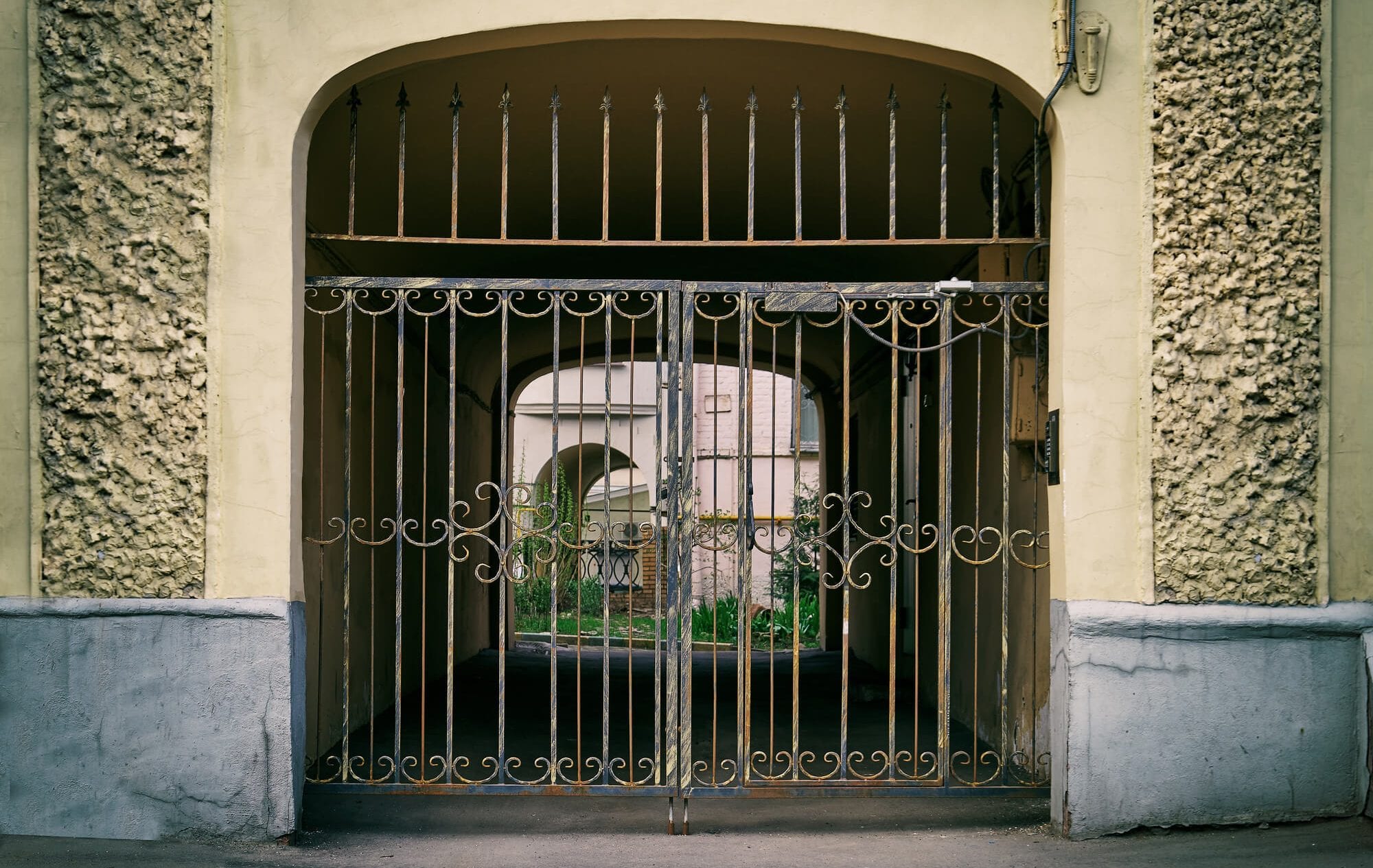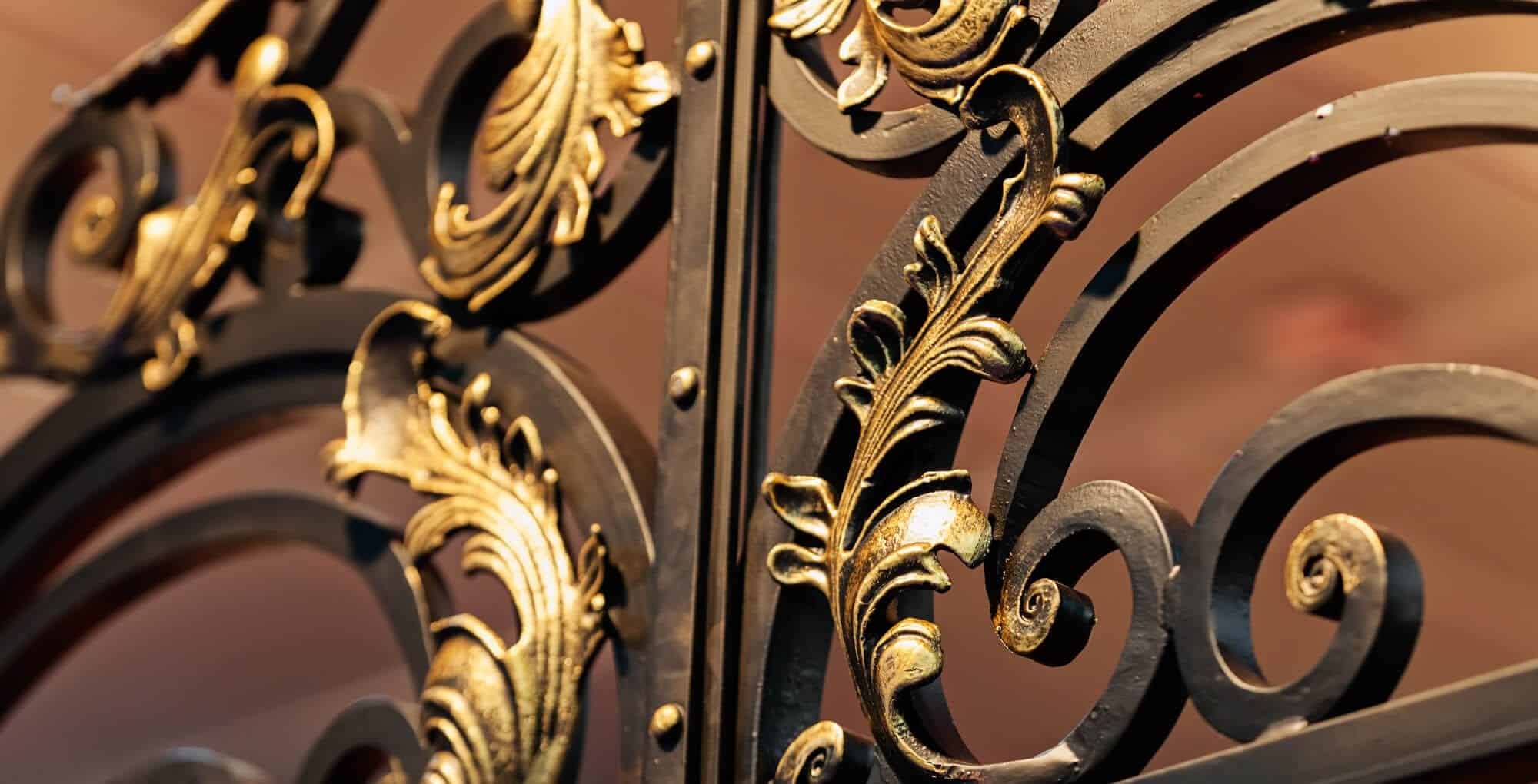Wrought iron is a durable material that has been used for thousands of years, first for tools and weaponry, then for fences, gates, balconies, and more. The material was discovered by ancient civilizations and has made a significant impact on world history.
While the use of iron began as early as 1500 BCE, primarily for swords and other weaponry, it wasn’t until the Iron Age when metalworkers began heat and melt the durable metal to make various architectural features. Wrought iron is easy to forge by hand, making it a popular fence style throughout history. Wrought iron,and it’s likenesses, are continuously used in modern times to add an air of sophistication to residential and commercial properties alike.
What is Wrought Iron?
By definition, wrought iron is a soft and malleable variety of the metal element iron obtained through smelting. Smelting is a process that utilizes heating and melting to extract the iron from its ore. Wrought iron is a relatively pure material consisting only of iron and small amounts of slag. The carbon content of wrought iron is less than 0.1%, helping to keep its moldable consistency.
What is “Wrought Iron” Today?
Wrought iron is an incredibly expensive fencing option when made from real iron. However, in today’s age, calling an ornamental metal fence “wrought” is factually incorrect, although wrought iron is the term commonly attributed to these kinds of fences. In reality, most modern ornamental fences and gates are composed of steel instead of wrought iron. The fence materials are manufactured to mimic the stylization that is typical of classic wrought iron fence construction.
While its use might not be quite as commonplace in modern applications, you can still view plenty of awe-inspiring wrought iron gates and fences across the globe. It was a popular material amongst wealthy and prominent people of past times. Even today, wrought iron materials and their steel counterparts are often used in the construction of:
- Fences
- Gates
- Railings
- Balconies
- Staircases
- Furniture
Although actual wrought iron is mostly obsolete in the residential fencing industry, its steel alternative is just as beautiful and offers an additional layer of protection around your home. Ornamental wrought iron fences are an ideal choice when installing your first fence because they are incredibly durable, beautiful, and will easily add immense value to your property.

Wrought Iron Fencing Through the Years
If “real” wrought iron is no longer used for fencing today, what purpose did it serve in the past? Let’s take a closer look at the lengthy history of the wrought iron fence.
The Origins of Iron
1. 1500 BCE
For the most part, many civilizations worldwide relied on bronze to make tools, pottery, weapons, and other metal objects. The period between 3000 and 1200 BCE is often referred to as the Bronze Age by historians. It wasn’t until 1500 BCE that iron was discovered by the ancient Hittites (1985), who used the malleable materials for crafting tools and weaponry that immensely improved their lives.
2. 500 BCE
Once the Hittites’ civilization collapsed, the use of iron quickly spread across the globe. After the introduction of iron into most established societies, the Iron Age began. Iron was commonly used for crafting cooking utensils, pots, and weaponry. The introduction of iron is directly attributed to advancing civilizations globally.
3. 400 CE
In the beginnings of the common era, civilizations continued to grow and learn how to hone their skills and crafts to create a better life for themselves. By 400 CE, societies saw the value of iron materials in construction and began to use wrought iron for ornamental and decorative purposes.
During this time, people were much more concerned with settling in one specific place and constructing permanent structures. Since wrought iron was extremely easy to work with, it became a staple material in modern construction. Doors, railings, gates, and other items were all iron-clad, offering immense stability and a certain eye-catching air of sophistication to many structures.
Moving Into Modern Times
1. The 1800s
By the 1800s, the use of iron was widespread across the world. One could often find wrought iron gates, fences, balconies, and other beautiful, ornamental displays of wrought iron craftsmanship on the grounds of the homes of wealthy individuals.
Between 1887 and 1889, the Eiffel Tower was constructed in France, offering a glimpse of the fantastic metalworking made possible through the use of wrought iron. The incredible feat of ironworking was put on display at the World’s Fair in 1889. Every wealthy aristocrat admired the beautiful handiwork completed by Gustave Eiffel, and wrought iron items became commonplace on the grounds of palaces, mansions, and other stately locations. You can still see many of these stunning examples of wrought iron metalworking when visiting popular tourist attractions across the globe.
2. The 1900s
After the end of the Industrial Age, the use of wrought iron for construction purposes sharply declined. Cheaper alternatives like steel and aluminum allowed average homeowners to install ornamental fences, gates, railings, and staircases on their property. The once austere fencing material was no longer made strictly for the sophisticated, upper-crust caste of society. With advancements in manufacturing processes, wrought iron alternatives were more accessible than ever. New technology and fencing materials made it possible for ordinary people to obtain a beautiful, wrought iron fence for their own property.
Wrought Iron Fencing in Present Day
After the Industrial Revolution, ironworking saw a steep decline as steel, which has many of the same properties as iron, erupted in popularity. Steel was a much cheaper commodity that could be manufactured quickly. Many fences advertised as “wrought iron” are actually a mixture of steel and iron metals. Both have similar properties, so modern “pseudo” wrought iron fences are just as durable and weather resistant.
Wrought iron fences can still be found on properties everywhere in modern times. Tourists enjoy the immense beauty of the hand-forged material at heritage sites throughout the world. Commercial property owners install wrought iron fences for added protection from intruders while simultaneously enhancing the business’s curb appeal. Homeowners often implement wrought iron fencing around their property as a durable yet stylistic choice. Found around yards, patios, pools, and sprawling driveways, ornamental wrought iron fences withstand the test of time and weather because of the metal’s strength and rust resistance.
The use of wrought iron, which literally translates to “worked iron,” in fencing products has been widespread over hundreds of years. The processes for forging the metal into beautiful and intricate fences have changed dramatically over time, but the final product’s visual impact has remained the same. Wrought iron is an attractive and long-lasting fence product that adds beauty to any property. If you’re interested in adding ornamental wrought iron fencing on your property, contact an experienced fencing company to assist in the installation of your beautiful new fence.


